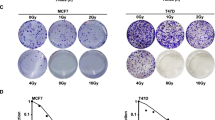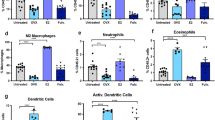Abstract
Sex steroid hormones play an essential role in the control of homeostasis in the mammary gland. Although the involvement of progesterone in cellular proliferation and differentiation is well established, its exact role in the control of cell death still remains unclear. As dysregulation of the apoptotic process plays an important role in the pathogenesis of breast cancer, we investigated the regulation of apoptosis by progesterone in various breast cancer cell lines. Our results show that progesterone treatment protects against radiation-induced apoptosis. This prevention appears to be mediated by the progesterone receptor and is unrelated to p53 status. There is also no correlation with the intrinsic hormonal effect on cell proliferation, as the presence of cells in a particular phase of the cell cycle. Surprisingly, progesterone partly allows bypassing of the irradiation-induced growth arrest in G2/M in PgR+ cells, leading to an increase in cell proliferation after irradiation. One consequence of this effect is a higher rate of chromosome damage in these proliferating progesterone-treated cells compared to what is observed in untreated irradiated cells. We propose that progesterone, by inhibiting apoptosis and promoting the proliferation of cells with DNA damage, potentially facilitates the emergence of genetic mutations that may play a role in malignant transformation.
This is a preview of subscription content, access via your institution
Access options
Subscribe to this journal
Receive 50 print issues and online access
$259.00 per year
only $5.18 per issue
Buy this article
- Purchase on Springer Link
- Instant access to full article PDF
Prices may be subject to local taxes which are calculated during checkout








Similar content being viewed by others
References
Alkhalaf M, El-Mowafy A and Karam S . (2002). Eur. J. Cancer Prev., 11, 481–488.
Bardon S, Vignon F, Montcourrier P and Rochefort H . (1987). Cancer Res., 47, 1441–1448.
Bernstein L . (2002). J. Mamm. Gland Biol. Neoplasia, 7, 3–15.
Biri A, Civelek E, Karahalil B and Sardas S . (2002). Mutat. Res., 521, 113–119.
Butt AJ, Firth SM, King MA and Baxter RC . (2000). J. Biol. Chem., 275, 39174–39181.
Clarke CL and Sutherland RL . (1990). Endocr. Rev., 11, 266–301.
Fenech M and Morley AA . (1985). Mutat. Res., 147, 29–36.
Feng Z, Marti A, Jehn B, Altermatt HJ, Chicaiza G and Jaggi R . (1995). J. Cell Biol., 131, 1095–1103.
Ferguson DJ and Anderson TJ . (1981). Br. J. Cancer, 44, 177–181.
Flototto T, Djahansouzi S, Glaser M, Hanstein B, Niederacher D, Brumm C and Beckmann MW . (2001). Horm. Metab. Res., 33, 451–457.
Formby B and Wiley TS . (1998). Ann. Clin. Lab. Sci., 28, 360–369.
Formby B and Wiley TS . (1999). Mol. Cell Biochem., 202, 53–61.
Gompel A, Somai S, Chaouat M, Kazem A, Kloosterboer HJ, Beusman I, Forgez P, Mimoun M and Rostene W . (2000). Steroids, 65, 593–598.
Graham JD and Clarke CL . (1997). Endocr. Rev., 18, 502–519.
Groshong SD, Owen GI, Grimison B, Schauer IE, Todd MC, Langan TA, Sclafani RA, Lange CA and Horwitz KB . (1997). Mol. Endocrinol., 11, 1593–1607.
Heermeier K, Benedict M, Li M, Furth P, Nunez G and Hennighausen L . (1996). Mech. Dev., 56, 197–207.
Hurd C, Khattree N, Alban P, Nag K, Jhanwar SC, Dinda S and Moudgil VK . (1995). J. Biol. Chem., 270, 28507–28510.
Juengel JL, Garverick HA, Johnson AL, Youngquist RS and Smith MF . (1993). Endocrinology, 132, 249–254.
Kandouz M, Lombet A, Perrot JY, Jacob D, Carvajal S, Kazem A, Rostene W, Therwath A and Gompel A . (1999). J. Steroid Biochem. Mol. Biol., 69, 463–471.
Kao GD, McKenna WG and Yen TJ . (2001). Oncogene, 20, 3486–3496.
Kester HA, Sonneveld E, van der Saag PT and van der Burg B . (2003). Exp. Cell Res., 284, 264–273.
Kester HA, van der Leede BM, van der Saag PT and van der Burg B . (1997). J. Biol. Chem., 272, 16637–16643.
Kirsch-Volders M, Elhajouji A, Cundari E and Van Hummelen P . (1997). Mutat. Res., 392, 19–30.
Kumar R, Vadlamudi RK and Adam L . (2000). Endocr. Relat. Cancer, 7, 257–269.
Lanari C and Molinolo AA . (2002). Breast Cancer Res., 4, 240–243.
Lange CA, Richer JK and Horwitz KB . (1999). Mol. Endocrinol., 13, 829–836.
Lebeau J, Fouchet P, Ory K and Chevillard S . (2002). Anticancer Res., 22, 2161–2166.
Levine AJ . (1997). Cell, 88, 323–331.
Lin VC, Jin R, Tan PH, Aw SE, Woon CT and Bay BH . (2003). Am. J. Pathol., 162, 1781–1787.
Luciano AM, Pappalardo A, Ray C and Peluso JJ . (1994). Biol. Reprod., 51, 646–654.
Lukic B and Barjaktarovic N . (1987). Mutat. Res., 191, 121–124.
Lydon JP, Ge G, Kittrell FS, Medina D and O'Malley BW . (1999). Cancer Res., 59, 4276–4284.
Metcalfe AD, Gilmore A, Klinowska T, Oliver J, Valentijn AJ, Brown R, Ross A, MacGregor G, Hickman JA and Streuli CH . (1999). J. Cell Sci., 112 (Part 11), 1771–1783.
Migliaccio A, Piccolo D, Castoria G, Di Domenico M, Bilancio A, Lombardi M, Gong W, Beato M and Auricchio F . (1998). EMBO J., 17, 2008–2018.
Murdoch WJ and Van Kirk EA . (2002). Mol. Cell. Endocrinol., 186, 61–67.
Musgrove EA, Swarbrick A, Lee CS, Cornish AL and Sutherland RL . (1998). Mol. Cell. Biol., 18, 1812–1825.
Ory K, Lebeau J, Levalois C, Bishay K, Fouchet P, Allemand I, Therwath A and Chevillard S . (2001). Breast Cancer Res. Treat., 68, 187–198.
Owen GI, Richer JK, Tung L, Takimoto G and Horwitz KB . (1998). J. Biol. Chem., 273, 10696–10701.
Pecci A, Scholz A, Pelster D and Beato M . (1997). J. Biol. Chem., 272, 11791–11798.
Rotello RJ, Lieberman RC, Lepoff RB and Gerschenson LE . (1992). Am. J. Pathol., 140, 449–456.
Sabourin JC, Martin A, Baruch J, Truc JB, Gompel A and Poitout P . (1994). Int. J. Cancer, 59, 1–6.
Schorr K, Li M, Krajewski S, Reed JC and Furth PA . (1999). J. Mamm. Gland Biol. Neoplasia, 4, 153–164.
Shim J, Lee H, Park J, Kim H and Choi EJ . (1996). Nature, 381, 804–806.
Sutherland RL, Prall OW, Watts CK and Musgrove EA . (1998). J. Mamm. Gland Biol. Neoplasia, 3, 63–72.
Thordarson G, Van Horn K, Guzman RC, Nandi S and Talamantes F . (2001). Carcinogenesis, 22, 1027–1033.
Acknowledgements
This work was supported by grants from Electricité de France (EDF).
Author information
Authors and Affiliations
Corresponding author
Rights and permissions
About this article
Cite this article
Vares, G., Ory, K., Lectard, B. et al. Progesterone prevents radiation-induced apoptosis in breast cancer cells. Oncogene 23, 4603–4613 (2004). https://doi.org/10.1038/sj.onc.1207601
Received:
Revised:
Accepted:
Published:
Issue Date:
DOI: https://doi.org/10.1038/sj.onc.1207601
Keywords
This article is cited by
-
Effects of Omega-3 Fatty Acids on Progestin Stimulation of Invasive Properties in Breast Cancer
Hormones and Cancer (2012)
-
Membrane Progesterone Receptors (mPRs) Mediate Progestin Induced Antimorbidity in Breast Cancer Cells and Are Expressed in Human Breast Tumors
Hormones and Cancer (2012)
-
Progesterone Receptor-B Induction of BIRC3 Protects Endometrial Cancer Cells from AP1-59-Mediated Apoptosis
Hormones and Cancer (2011)
-
Role of the progesterone receptor for paclitaxel resistance in primary breast cancer
British Journal of Cancer (2007)



